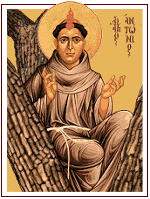
 |
|
| The Alamo was once known as Mission San Antonio
de Valero. It was named for its patron saint, Saint Anthony of Padua,
and for the Marquis de Valero.
Patron saints are chosen as special protectors or guardians over areas of life. These areas can include occupations, illnesses, churches, countries, causes — anything that is important. The earliest records show that people and churches were named after apostles and martyrs as early as the fourth century.
The name of the mission may be derived from the San Antonio de Padua Pueblo founded by Father Damien Massanet in 1691. This pueblo was the basis for the settlement of San Fernando de Béjar. However, It may very well have been Father Olivares's devotion to the Saint that determined the choice of Saint Anthony as the mission's patron. For it was Olivares who directed the construction of the church.
Whatever the reason, Saint Anthony was the appropriate choice. As the Patron Saint of the Poor he watched over Father Olivares, who had little, and over his Indian charges who had even less.
St. Anthony (in Spanish, San Antonio) was born Fernando Bulhom in Lisbon, Portugal in the year 1195, although most of his work was in Italy. He originally joined the Augustinian order, but he became a Franciscan at the age of 26.
He is called the "Hammer of Heretics" because of his simple, and sometimes, miraculous manner of teaching the Catholic faith. The secret to his success was simply to repeat the "Holy Name of Mary" when speaking to heretics.
St. Anthony often attracted huge crowds, and was sensationally successful. One day when he found he was preaching to heretics who would not Listen, he went to preach to the fish, who Listened attentively, not for their necessity, but for the glory of God. To another heretic, St. Anthony had a mule (who had been starved for three days) bow before the Blessed Sacrament, although food was also placed near him. St. Anthony was miraculously visited by the Infant Jesus, and is commonly referred to today as the "finder of lost articles." His tongue is incorrupt, and is displayed at the Vatican. St. Anthony died at the age of 36 in the year 1231. Facts About San Antonio de Padua: He is know as the "Doctor of the Church" See Also: Finding the Real St. Anthony at American Catholics Online. |
|
|
Courtesy Catholic
Online. Used with permission.
|
|
|
*Marquis de Valero Don Baltasar de Zuniga, Sotomayor, Mendoza y Guzman was the second Marquis de Valero, born in the ducal palace of Bejar, province of Salamanca [,Spain]and baptized there 9 January 1659. His elder brother was Manuel de Zuniga, the11th Duke of Bejar. He was born in 1657. He died in the Catholic effort to retake Buda and Pest from the Turks; Baltasar was wounded in the same siege. Manuel was buried in the convent of the Dominican Sisters in Bejar. According to the New Handbook of Texas, the Marques de San Miguel de Aguayo came to Mexico in 1712 to live with his wife on one of their haciendas, Patos, which included almost half of Coahuila. The same article indicates he died and was buried in the chapel of Santa Maria de las Parras. The titles Valero and Bejar were passed down to various members of the Zuniga family of the Bejar District in Spain. The family lands are located there. Miguel, the Duke de Bejar, was a priest who was killed in the last Catholic attempt to push the Turks out of Budapest. His brother Baltazar, the Marquis de Valero was briefly the Viceroy of New Spain at the time Father Olivares founded the Mission of San Antonio de Valero (The Alamo). The expedition to the San Antonio was authorized by Valero, so the presidio was named in honor of Bejar and the Mission in honor of Valero. Valero returned to Spain at the end of his term. The family is related by marraige to Herman Cortez. It is interesting to note that one of the Valero family killed one of the Aguayo family in a feud during the 1600's. Source: Alamo Forum |